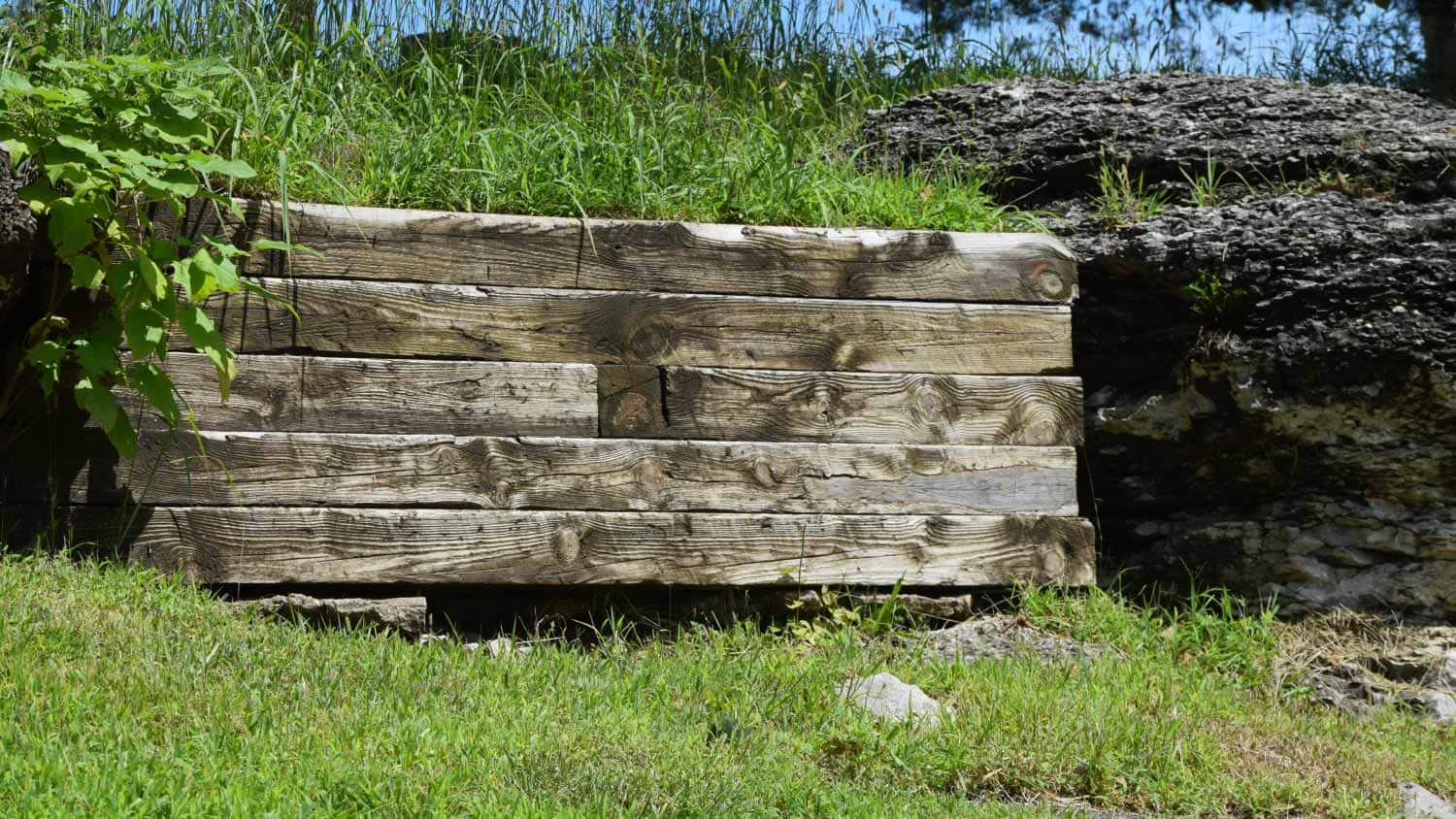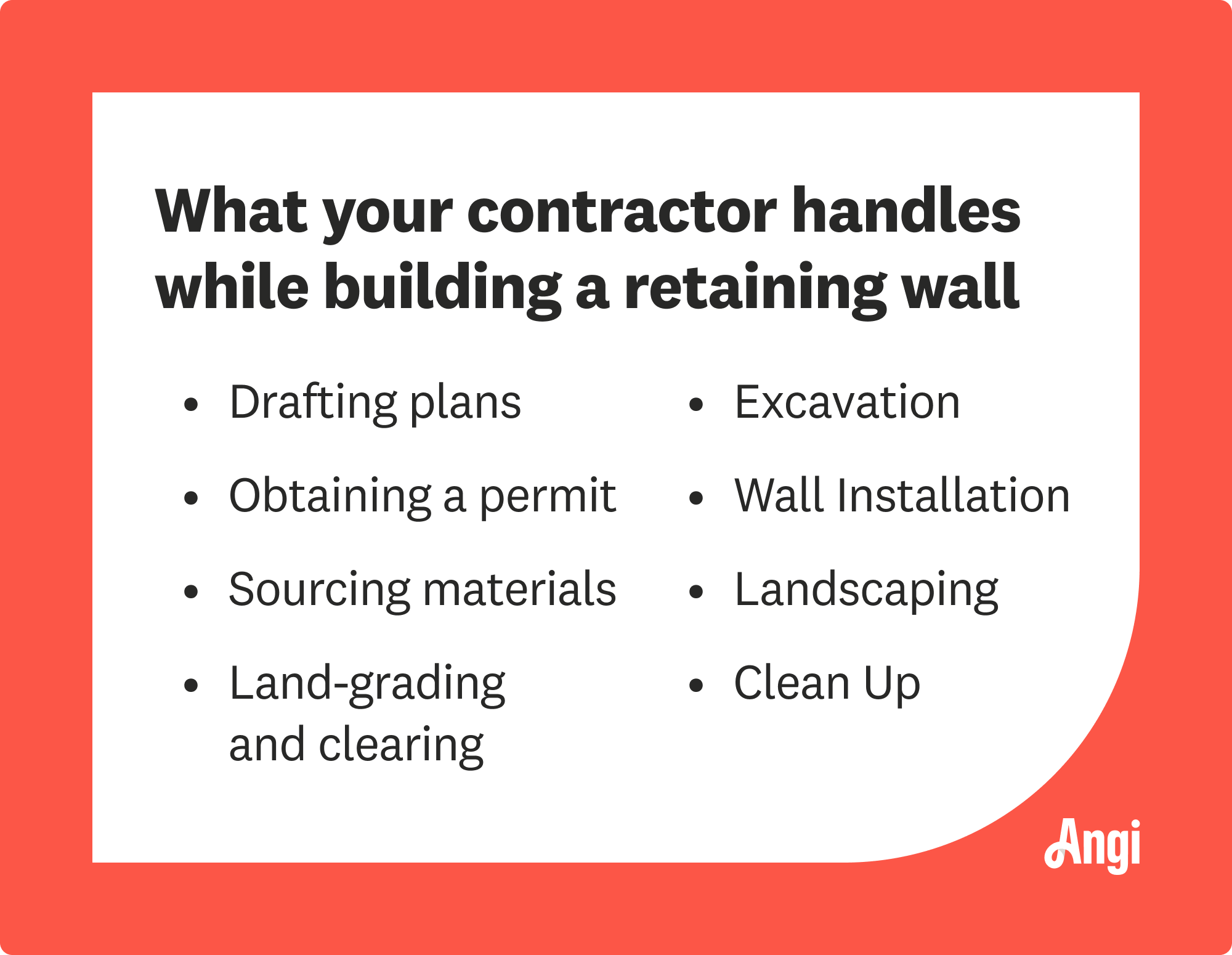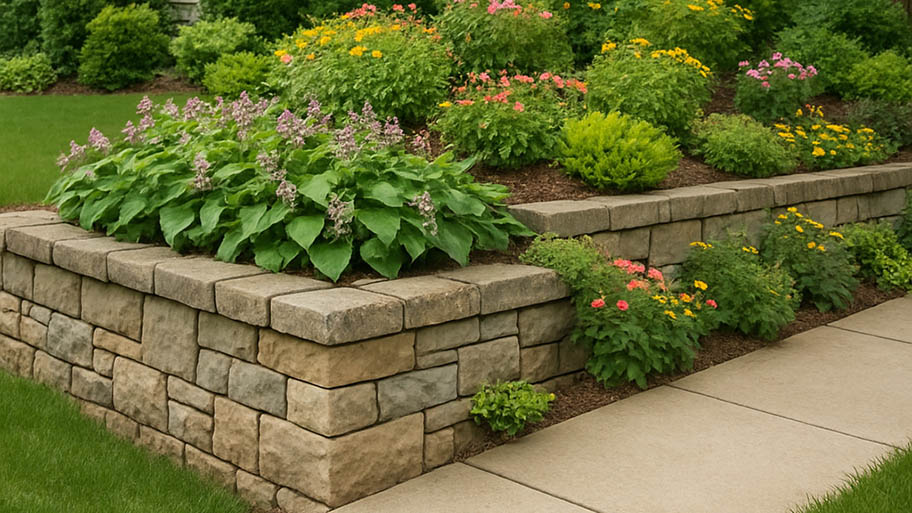
Landscape curbing can really improve the look of a yard, but at what cost? Find out how much it costs and the different ways you can do it
The average railroad tie retaining wall costs $2,200 for 20 linear feet, and most homeowners pay between $1,500 and $3,000 depending on the height, reinforcements, and site prep.


The height and length of your wall are the two most crucial cost factors and will largely determine your total.
Retaining walls over 4 feet tall require reinforcements, increasing costs by 10% to 20%.
You may need a foundation to support your retaining wall, which can double the cost per linear foot.
Don’t forget to budget for permits, backfilling, and drainage, which can collectively add thousands to your total cost.
The typical railroad tie retaining wall costs $2,200 to install, and most homeowners pay somewhere between $1,500 and $3,000 for 20 linear feet of wall at 2 feet high. For different wall heights and lengths, you can use the average price of $25 to $30 per square foot. In addition to the wall length and height, costs can rise depending on the design and installation.
There are a few factors that you need to consider if you want to budget accurately for your railroad tie retaining wall.
Simply put, the larger your wall, the more it’s going to cost. Most retaining walls are between 2 and 4 feet in height. If you want a taller wall that requires reinforcement and a solid foundation, your price will be significantly higher than the average. For example, a 2-foot-tall wall will cost $50 per linear foot on the low end, while a 6-foot-tall wall could cost more than $180 per linear foot. Here are some common retaining wall sizes and costs.
| Length (Linear Feet) | Average Cost Range | Average Cost |
|---|---|---|
| 10 | $500–$1,800 | $1,150 |
| 15 | $750–$2,700 | $1,730 |
| 20 | $1,000–$3,600 | $2,300 |
| 25 | $1,250–$4,500 | $2,880 |
| 30 | $1,500–$5,400 | $3,450 |
| 50 | $2,500–$9,000 | $5,750 |
| 100 | $5,000–$18,000 | $11,500 |
| 150 | $7,500–$27,000 | $17,250 |
If you’re installing a railroad tie retaining wall over sloped land, expect labor costs to increase by 50% or more. Your contractor will have to excavate the area and terrace the slope, which requires a significant amount of extra work.
Costs will also increase if you build a retaining wall in an area with unstable or rocky soil. Your contractor will have to do extra work to make sure the dirt is compact enough to support the wall.
The cost of your retaining wall depends on the design. A simple, straight retaining wall is typically the most affordable. Elaborate designs—including elements like curves, steps, openings, and flower beds—cost more because they take longer to install.
Labor is a large portion of the cost to build a railroad tie retaining wall. Most contractors charge between $50 and $75 per hour, but you may pay more in an area with a higher cost of living. It can take anywhere from six hours to a few work days to build a retaining wall, depending mostly on the excavation required, the desired design, and whether or not you need a foundation and reinforcements for your retaining wall.

Before you get a permit, you may need to hire a local structural engineer or local landscape architect to draft plans for your retaining wall. These plans ensure that your wall meets all residential safety codes and will be able to hold back the soil behind it without sustaining damage or collapsing. Most structural engineers cost $100 to $200 per hour, with homeowners spending $300 to $3,000 per project.
Depending on the size of your retaining wall, you may need a permit before you can start the installation. Generally, a building permit costs somewhere between $60 and $500—but different areas have different regulations, especially when it comes to treated wood.
Railroad ties are extremely durable because they are often soaked in creosote, which prevents it from rotting as quickly as untreated wood. Some areas have banned or heavily regulated the use of railroad ties. For this reason, it’s hard to find and purchase railroad ties, even at big box stores. Most of the time, contractors get them from dealers since they're reclaimed.
You can always use alternative options, like untreated wood or railroad ties made from recycled plastic, so check with your local municipality on what the permitting process entails before installation.
Tip: Traditional railroad ties are treated with creosote, which might be banned in your local area. According to the Environmental Protection Agency (EPA), creosote may pose a health risk to humans and wildlife. Instead, you may want to consider modern alternatives made from recycled plastic or composite, which offer a very similar look to reclaimed railroad ties.
Before your contractor can build a retaining wall, they’ll need to prepare the land. This can include a number of different jobs—from excavation to tree removal. Each will increase total costs. The table below includes some things to consider.
| Site Prep | Typical Cost |
|---|---|
| Excavation | $50–$200 per cubic yard |
| Leveling and grading | $1–$2 per sq. ft. |
| Tree removal | $150–$2,000 per tree |
If your wall is more than 4 feet tall, you’ll need to reinforce it with steel rebar (though local building codes may differ, especially if you live in an area prone to earthquakes). Reinforcements often add $2.50 to $5 per square foot. The table below includes a look at pricing for reinforcements for a 20-foot wall at different heights. Keep in mind that you’ll need to add these prices onto the total wall cost.
| Wall Height (ft.) | Wall Length (ft.) | To Add Reinforcement |
|---|---|---|
| 5 | 20 | $250 – $500 |
| 6 | 20 | $300 – $600 |
| 7 | 20 | $350 – $700 |
| 8 | 20 | $400 – $800 |
If your railroad tie retaining wall is more than 4 feet tall, you’ll also need to install footings to create a sturdy foundation. Expect to spend an additional $18 to $55 per linear foot to pour adequate footings. Footings are typically concrete and rest below the ground, where they offer support while remaining out of sight. Your retaining wall installer can anchor your wall to the footings to provide the additional support necessary to hold back larger amounts of soil.
Many homeowners use retaining walls to prevent erosion in their yard. In this case, drainage is a worthwhile addition that also helps prevent pooling and flooding. For most homeowners, landscape drainage costs between $2,100 and $6,500, though you can install a basic system for a little as $500.
Any time water pools and collects you risk drowning your plants or, even worse, fungus growth. Fungus loves to grow in wet areas. If it doesn’t dry it can kill your plants, grass, and the surrounding yard.
When your contractor builds your retaining wall, they may need to backfill any area they’ve excavated. Depending on your wall’s design, this could add a significant cost. Expect to spend anywhere from $5 to $30 per cubic yard on the cost of fill dirt in addition to your contractor’s hourly labor rate. The total for this line item car vary widely, from nothing at all to thousands of dollars, depending on your particular situation.
While you’re working on the budget for the upfront cost to install a railroad tie retaining wall, it’s worth considering some ongoing things you might need to pay for to maintain your new landscaping feature.
If you’re using real wood railroad ties, you might need to carry out maintenance from time to time to keep the wood looking clean and tidy. Depending on the size of the wall, you could pay anywhere from $60 to $500 to pressure wash the wood to remove mold and algae.
You might also want to sand and reseal your railroad ties to keep them better protected from moisture in the surrounding soil. Sanding or sandblasting will often cost around $2 per square foot. Applying new sealant afterward should cost between $0.75 and $4 per square foot.
For both sandblasting and resealing, you’d be looking at a cost of between $220 and $480 per 80 square feet.
You may also need to repair your railroad tie retaining wall, which can get expensive, depending on the work you need done.
Replacing a single rotted railroad tie can range from $150 up to $1,000, depending on its location in the wall. Repairs to the footings under tall retaining walls will often require excavation and repouring of the concrete base, which can cost anywhere from $400 to $1,500, depending on a few factors, like wall height, soil quality, and more.
Rotting railroad ties can attract wood-destroying insects like carpenter ants and termites, which can make their way into your home after destroying your retaining wall. It’s a good idea to have your wall treated for insects to avoid infestations. You can expect to pay between $100 and $300 every three months for quarterly visits. Keep in mind that this cost will often include protection for your retaining wall as well as your main structure.

If you’re only planning on installing a small, 2-foot-tall retaining wall or something even shorter, then you can probably get away with doing it as a DIY project if you have some experience. For anything taller, building a retaining wall is no simple DIY.
This challenging project requires construction experience and knowledge of the soil conditions in your area. Larger walls typically require permits, too, and you need a pro to submit the plans before your building department will sign off. In this case, DIY isn’t an option.
Even so, construction mistakes can lead to costly fixes. You may not end up saving money if your DIY retaining wall collapses or causes flooding and erosion on your property. It can also be pretty dangerous. Instead, it’s best to hire a landscape contractor near you.
Many homeowners don’t just build a retaining wall—they also add other landscaping features to elevate their property even further. This makes the wall look like an intentional part of your landscape design rather than a way to create a usable, level area in your yard. Consider adding the following to your budget:
Flower bed costs: $1,000–$3,000
Landscape lighting costs: $2,000–$6,000
Fence installation costs: $1,750–$4,400
Building a patio costs: $1,950–$5,650
Planting a tree costs: $100–$2,000
Retaining walls can quickly become expensive projects, especially if you have a wall over 4 feet tall or need drainage and reinforcements. Some homeowners pay up to $27,000 for their retaining wall. Luckily, there are some ways you can save.
While we’d strongly suggest hiring a professional to build your wall, you can save money by tackling some of the smaller line items involved in this job. If you’ve got a green thumb, you can re-install landscaping around your retaining wall without the help of a pro. Mulching flower beds, installing shrubbery, and planting grass seed yourself will bring the area to life on a budget.
Since intricate designs take longer to build, you can save money by keeping things simple. Choose a straight retaining wall (rather than curved) and limit the number of stairs or openings.
Once your retaining wall is taller than 4 feet, it will need more structural support and reinforcements. This comes with additional costs, like laying down concrete footings and reinforcing the wall with steel rebar. You can shave money off your budget by opting for a shorter wall if your space allows for it.
From average costs to expert advice, get all the answers you need to get your job done.

Landscape curbing can really improve the look of a yard, but at what cost? Find out how much it costs and the different ways you can do it

What are average sod installation prices? Learn how much sod costs based on factors like square footage, land prep, land condition, and more.

How much does hardscaping cost project by project? Check out our breakdown for every price tag you need to know, from outdoor fireplaces to patios.

Get a clear breakdown of geotechnical report costs, including average prices, cost factors, and tips to help homeowners budget for their project.

There is no one-size-fits-all retaining wall for your yard. In fact, the options are endless. Check out 20 retaining wall ideas to upgrade your hardscape.

Why does your grass keep dying, despite your best efforts? Lawn care can be a tricky process. Find out why you might see dead grass and what you can do about it.